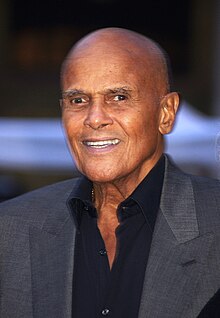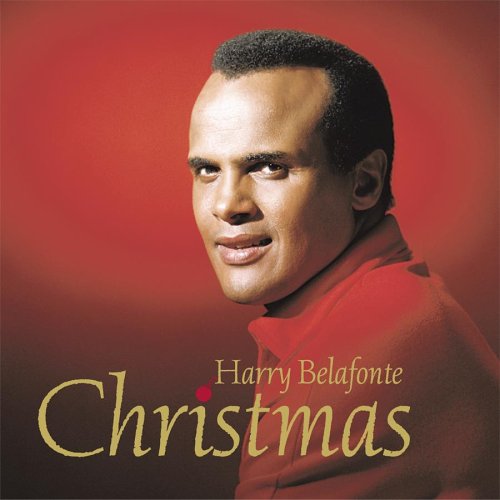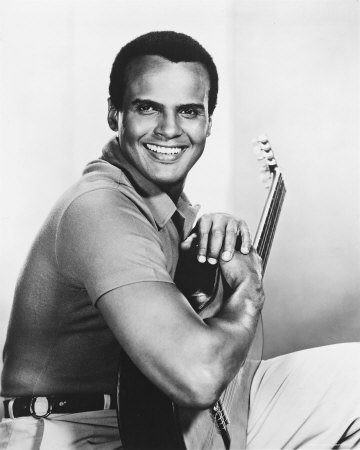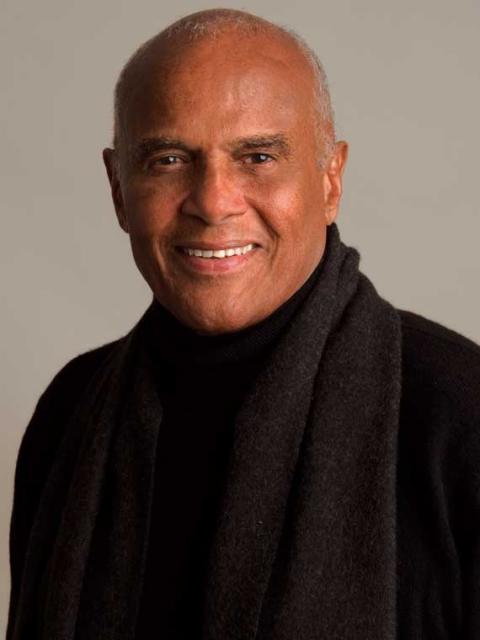Harry Belafonte
Born Harold George Belafonte, Jr., at Lying-in Hospital, New York City, New York, Belafonte was the son of Melvine (née Love) – a housekeeper (of Jamaican descent) – and Harold George Belafonete, Sr., a Martiniquan who worked as chef in the Royal Navy. From 1932 to 1940, he lived with his grandmother in her native country of Jamaica. When he returned to New York City, he attended George Washington High School after which he joined the Navy and served during World War II. In the 40s, he was working as a janitor's assistant in NYC when a tenant gave him 2 tickets to the theater as a gratuity. He fell in love with the art form and also met Sydney Poitier. The financially struggling pair regularly purchased a single seat to local plays, trading places in between acts, after informing the other about the progression of the play. At the end of the 1940s, he took classes in acting at the Dramatic Workshop of The New School in New York with the influential German director Erwin Piscator alongside Marlon Brando, Tony Curtis, Walter Matthau, Bea Arthur and Sidney Poitier, while performing with the American Negro Theatre. He subsequently received a Tony Award for his participation in the Broadway revue John Murray Anderson's Almanac.
Belafonte started his career in music as a club singer in New York to pay for his acting classes. The first time he appeared in front of an audience, he was backed by the Charlie Parker band, which included Charlie Parker himself, Max Roach and Miles Davis, among others. At first he was a pop singer, launching his recording career on the Roost label in 1949, but later he developed a keen interest in folk music, learning material through the Library of Congress' American folk songs archives. With guitarist and friend Millard Thomas, Belafonte soon made his debut at the legendary jazz club The Village Vanguard. In 1952 he received a contract with RCA Victor.
His first widely–released single, which went on to become his "signature" song with audience participation in virtually all his live performances, was "Matilda," recorded April 27, 1953. His breakthrough album Calypso (1956) became the first LP to sell over 1 million copies (Bing Crosby's "White Christmas" and Tennessee Ernie Ford's "Sixteen Tons," both singles, had previously surpassed that mark). The album is number four on Billboard's "Top 100 Album" list for having spent 31 weeks at number 1, 58 weeks in the top ten, and 99 weeks on the U.S. charts. The album introduced American audiences to Calypso music (which had originated in Trinidad and Tobago in the early 20th century), and Belafonte was dubbed the "King of Calypso," a title he wore with reservations, since he had no claims to any Calypso Monarch titles.
One of the songs included in the album is the now famous "Banana Boat Song" (listed as "Day O" on the original release), which reached number five on the pop charts, and featured its signature lyric "Day–O." Belafonte based his version on a 1954 recording by Jamaican folk singer Louise Bennett. His other smash hit was "Jump in the Line."
Many of the compositions recorded for Calypso, including "Banana Boat Song" and "Jamaica Farewell," gave songwriting credit to Irving Burgie, Belafonte and his team but were really previously recorded Jamaican mento songs sold as calypso. The original Jamaican versions can now be heard on the "Jamaica—Mento1951–1958" CD released in 2010.
While primarily known for Calypso, Belafonte has recorded in many genres, including blues, folk, gospel, show tunes, and American standards. His second–most popular hit, which came immediately after "The Banana Boat Song," was the novelty tune "Mama Look at Bubu," also known as "Mama Look a Boo–Boo" (originally recorded by Lord Melody in 1956), in which he sings humorously about misbehaving and disrespectful children. It reached number eleven on the pop chart.
In 1959 he starred in Tonight With Belafonte, a nationally televised special that featured Odetta, who sang Water Boy and who performed a duet with Belafonte of There's a Hole in My Bucket that hit the national charts in 1961. Belafonte continued to record for RCA through the 1950s to the 1970s. Two live albums, both recorded at Carnegie Hall in 1959 and 1960, enjoyed critical and commercial success. From his 1959 album, Hava Nagila became part of his regular routine and one of his signature songs. He was one of many entertainers recruited by Frank Sinatra to perform at the inaugural gala of President John F. Kennedy in 1961. That same year he released his second calypso album, Jump Up Calypso, which went on to become another million seller. During the 1960s he introduced several artists to American audiences, most notably South African singer Miriam Makeba and Greek singer Nana Mouskouri. His album Midnight Special (1962) featured the first–ever record appearance by a then young harmonica player named Bob Dylan.
As The Beatles and other stars from Britain began to dominate the U.S. pop charts, Belafonte's commercial success diminished; 1964's Belafonte at The Greek Theatre was his last album to appear in Billboard's Top 40. His last hit single, A Strange Song, was released in 1967 and peaked at number 5 on the Adult contemporary music charts. Belafonte has received Grammy Awards for the albums Swing Dat Hammer (1960) and An Evening with Belafonte/Makeba (1965). The latter album dealt with the political plight of black South Africans under Apartheid. He earned six Gold Records. Belafonte's recording activity slowed after leaving RCA in the 1970s. From the mid–1970s to early 1980s he spent the greater part of his time touring Japan, Europe, Cuba and elsewhere. His involvement in USA for Africa during the mid–1980s resulted in renewed interest in his music, culminating in a record deal with EMI. He subsequently released his first album of original material in over a decade, Paradise in Gazankulu, in 1988. The album contains ten protest songs against the South African former Apartheid policy and as of 2011 was his last studio album. In the same year Belafonte, as UNICEF Goodwill Ambassador, attended a symposium in Harare, Zimbabwe to focus attention on child survival and development in Southern African countries. As part of the symposium, he performed a concert for UNICEF. A Kodak video crew filmed the concert, which was released as a 60-minute concert video entitled "Global Carnival." It features many of the songs from the album Paradise in Gazankulu and some of his classic hits. Also in 1988, Tim Burton used "The Banana Boat Song" and "Jump in the Line" in his movie Beetlejuice." Following a lengthy recording hiatus, An Evening with Harry Belafonte and Friends, a soundtrack and video of a televised concert were released in 1997 by Island Records. The Long Road to Freedom, An Anthology of Black Music, a huge multi–artist project recorded during the 1960s and 1970s with RCA, was finally released by the label in 2001. The album was nominated for the 2002 Grammy Awards for Best Boxed Recording Package, for Best Album Notes and for Best Historical Album.[citation needed]
Belafonte started his career in music as a club singer in New York to pay for his acting classes. The first time he appeared in front of an audience, he was backed by the Charlie Parker band, which included Charlie Parker himself, Max Roach and Miles Davis, among others. At first he was a pop singer, launching his recording career on the Roost label in 1949, but later he developed a keen interest in folk music, learning material through the Library of Congress' American folk songs archives. With guitarist and friend Millard Thomas, Belafonte soon made his debut at the legendary jazz club The Village Vanguard. In 1952 he received a contract with RCA Victor.
His first widely–released single, which went on to become his "signature" song with audience participation in virtually all his live performances, was "Matilda," recorded April 27, 1953. His breakthrough album Calypso (1956) became the first LP to sell over 1 million copies (Bing Crosby's "White Christmas" and Tennessee Ernie Ford's "Sixteen Tons," both singles, had previously surpassed that mark). The album is number four on Billboard's "Top 100 Album" list for having spent 31 weeks at number 1, 58 weeks in the top ten, and 99 weeks on the U.S. charts. The album introduced American audiences to Calypso music (which had originated in Trinidad and Tobago in the early 20th century), and Belafonte was dubbed the "King of Calypso," a title he wore with reservations, since he had no claims to any Calypso Monarch titles.
One of the songs included in the album is the now famous "Banana Boat Song" (listed as "Day O" on the original release), which reached number five on the pop charts, and featured its signature lyric "Day–O." Belafonte based his version on a 1954 recording by Jamaican folk singer Louise Bennett. His other smash hit was "Jump in the Line."
 Harry Belafonte |  Harry Belafonte - Wikipedia |  Harry Belafonte |  Harry Belafonte |  Video: Harry Belafonte Falls |
 Harry Belafonte |  Harry Belafonte |  Harry Belafonte Christmas |  HW Pick: Harry Belafonte\x26#39;s New |  Harry Belafonte Memoir and HBO |
In 1959 he starred in Tonight With Belafonte, a nationally televised special that featured Odetta, who sang Water Boy and who performed a duet with Belafonte of There's a Hole in My Bucket that hit the national charts in 1961. Belafonte continued to record for RCA through the 1950s to the 1970s. Two live albums, both recorded at Carnegie Hall in 1959 and 1960, enjoyed critical and commercial success. From his 1959 album, Hava Nagila became part of his regular routine and one of his signature songs. He was one of many entertainers recruited by Frank Sinatra to perform at the inaugural gala of President John F. Kennedy in 1961. That same year he released his second calypso album, Jump Up Calypso, which went on to become another million seller. During the 1960s he introduced several artists to American audiences, most notably South African singer Miriam Makeba and Greek singer Nana Mouskouri. His album Midnight Special (1962) featured the first–ever record appearance by a then young harmonica player named Bob Dylan.
 Harry Belafonte |  Harry Belafonte - Wikipedia |  The meeting includes |  Harry Belafonte - Songs |  Just enjoy Harry Belafonte. |
 HW Pick: Harry Belafonte\x26#39;s New |  Harry Belafonte - Belafonte |  Harry Belafonte - More Posters |  Harry Belafonte - An Evening |  Harry Belafonte |

0 Comments:
Post a Comment
Subscribe to Post Comments [Atom]
<< Home